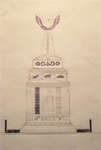"A Bad Deal for Six Nations"
- Publication
- Tekawennake News (Ohsweken, Ontario), 15 Apr 1992, p.3
- Full Text
- A bad deal for Six Nationsby Cheryl MacDonald
Back in the 1820's enterprising businessman believed water transportation would be the key to unlock the riches of the continent. As a result, a frenzy of canal building took place.
Within a very short time span, the Lachine Canal was finished near Montreal, the Rideau near Ottawa (then Bytown), and the Welland near St. Catherines.
To provide an adequate water supply to the Welland Canal, a Feeder Canal was built from the Grand River at Dunnville. Once shipping opened on the canal, William Hamilton Merritt, the power behind the project, turned his attention to the Grand River.
In fact, as early as 1822 a government surveyor, Samuel Clowes had studied the Grand, with a view to future development. It was not until December 15, 1827, however, that the first public meeting on the possible development of the Grand River was held, at Lovejoy's Inn, Brantford.
As a result of that meeting and further studies, the Grand River Navigation Company was incorporated in 1832.
At the time, most Canadian developers were extremely short of cash. In 1930, the province itself was in debt to the tune of $130,000. Realizing that huge sums of money would be needed to finance the navigation system, the company decided to tap into an unusual source: the Six Nations Iroquois.
Some thirty years earlier, Joseph Brant had found himself at the centre of a dispute over whether or not Indians had the right to sell their own land. At the time, the British government ruled that transactions must be handled through them. Proceeds from the sales were placed in British government bonds, which accrued an annual interest of three per cent. Although settlement along the Grand River had been somewhat slower than in other areas of the province, enough land transactions had taken place by the late 1820's for the Six Nations to have assumed considerable capital.
William Hamilton Merritt, who saw the Grand River Navigation Company as a compliment to the Welland Canal, persuaded Ontario's Lieutenant-Governor, Sir John Colbome, to use Indian funds to finance the navigation company. Historian B.E. Hill has speculated that Colborne, agreed to this unusual arrangement for two reasons.
First, he was a strong supporter of canal schemes, and had in fact loaned the Welland Canada Company $10,000 of his personal fortune. Secondly, he realized that the Six Nations did not have a prosperous economy. Hunting grounds along the Grand were not rich enough to maintain native inhabitants in comfort and many had not made the transition to full-time farming; Colborne likely reasoned that the navigation scheme would open up the area, increase the value of Indian lands, and bring prosperity to the native residents.
John Henry Dunn, for whom Dunnville was named, was also involved in the scheme. Dunn, a personal friend of Merritt, was Receiver-General of Upper Canada from 1820 to 1843, and since a clerk in the Receiver-General's department served as accountant for the Six Nations trust funds, Dunn had to be aware how much money was available.
Arrangements were made for the sale of 8,000 shares. Merritt was to hold 2,000, David Thomspon of Indiana, north of Cayuga, would have another 2,000, a similar number would be purchased on behalf of the Six Nations, and the remaining 25 per cent of shares would be sold to private shareholders. Furthermore, in addition to money obtained through the sale of shares to the Six Nations, the Grand River Navagation Company was granted 200 acres of land at each lock and dam site, all of which belonged to the Indians.
Typically, neither the government nor the Grand River Navigation Company bothered to ask the Six Nations whether or not they approved of the scheme.
In 1834, as a result of their protests, the government informed the principals of the Grand River Navagation Company that the promised Indian lands could not be ceded to them. Merritt and Thompson felt the land was essential to the successful completion of the scheme, and because Lieutenant-Governor Colborne had more or less promised that the land would be forthcoming. Because it was not, Merritt and Thompson felt it only fair the Colborne buy out their shares. On behalf of the government, Colborne did so, using more of the Six Nations' trust fund. They now owned at least 75 per cent of the shares of the Grand River Navigation Company; by 1840, because of sluggish sales to small shareholders, they would own more than 80 per cent. And not once in the brief history of the navigation company would the Six Nations ever receive a direct dividend payment.
Cheryl MacDonald is a freelance writer for the Simcoe Saturday Times.
- Creator
- MacDonald, Cheryl, Author
- Media Type
- Newspaper
- Item Types
- Articles
- Clippings
- Description
- This article details the unauthorized use of funds belonging to the Six Nations of the Grand River to fund the development of the Grand River Navigation Company.
- Publisher
- Tekawennake News
- Place of Publication
- Six Nations of the Grand River, ON
- Date of Publication
- 15 Apr 1992
- Subject(s)
- Personal Name(s)
- Merritt, William Hamilton ; Clowes, Samuel ; Brant, Joseph ; Colborne, Sir John ; Hill, B. E. ; Dunn, John Henry ; Thompson, David.
- Corporate Name(s)
- Grand River Navigation Company ; Welland Canada Company.
- Local identifier
- SNPL002053v00d
- Language of Item
- English
- Geographic Coverage
-
-
Ontario, Canada
Latitude: 43.06681 Longitude: -80.11635
-
- Creative Commons licence
 [more details]
[more details]- Copyright Statement
- Public domain: Copyright has expired according to Canadian law. No restrictions on use.
- Copyright Date
- 1992
- Copyright Holder
- Tekawennake News
- Contact
- Six Nations Public LibraryEmail:info@snpl.ca
Website:
Agency street/mail address:1679 Chiefswood Rd
PO Box 149
Ohsweken, ON N0A 1M0
519-445-2954



